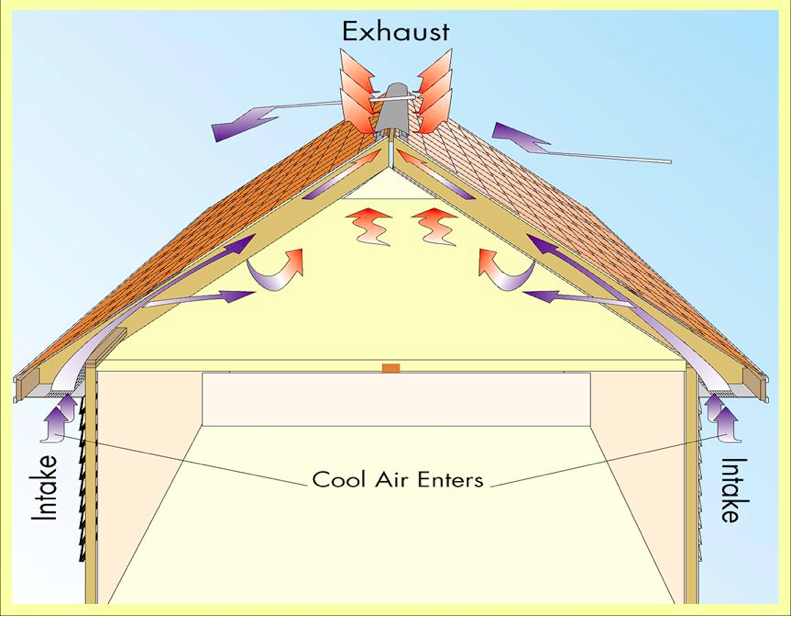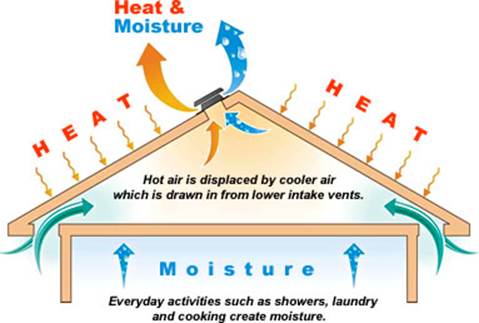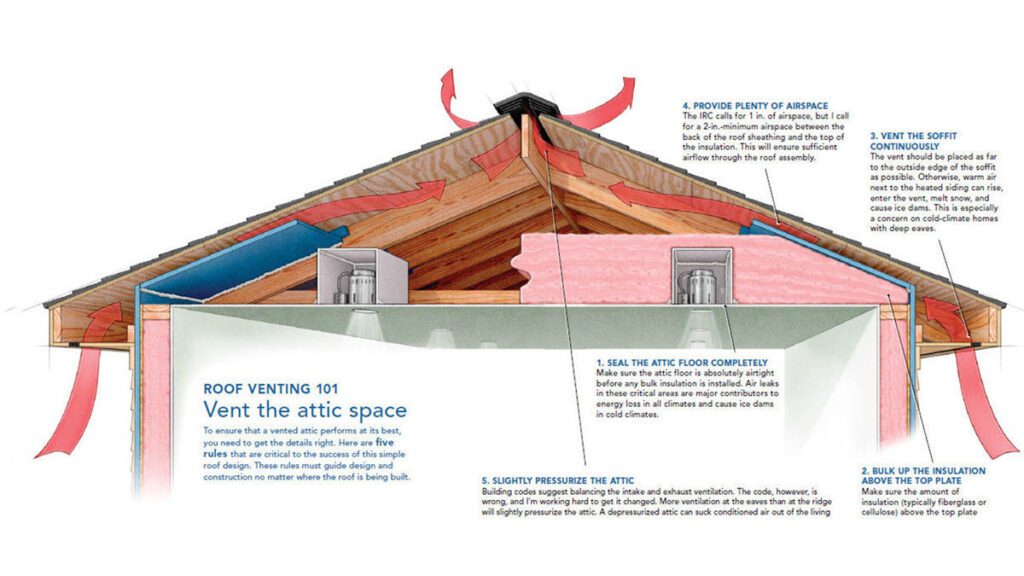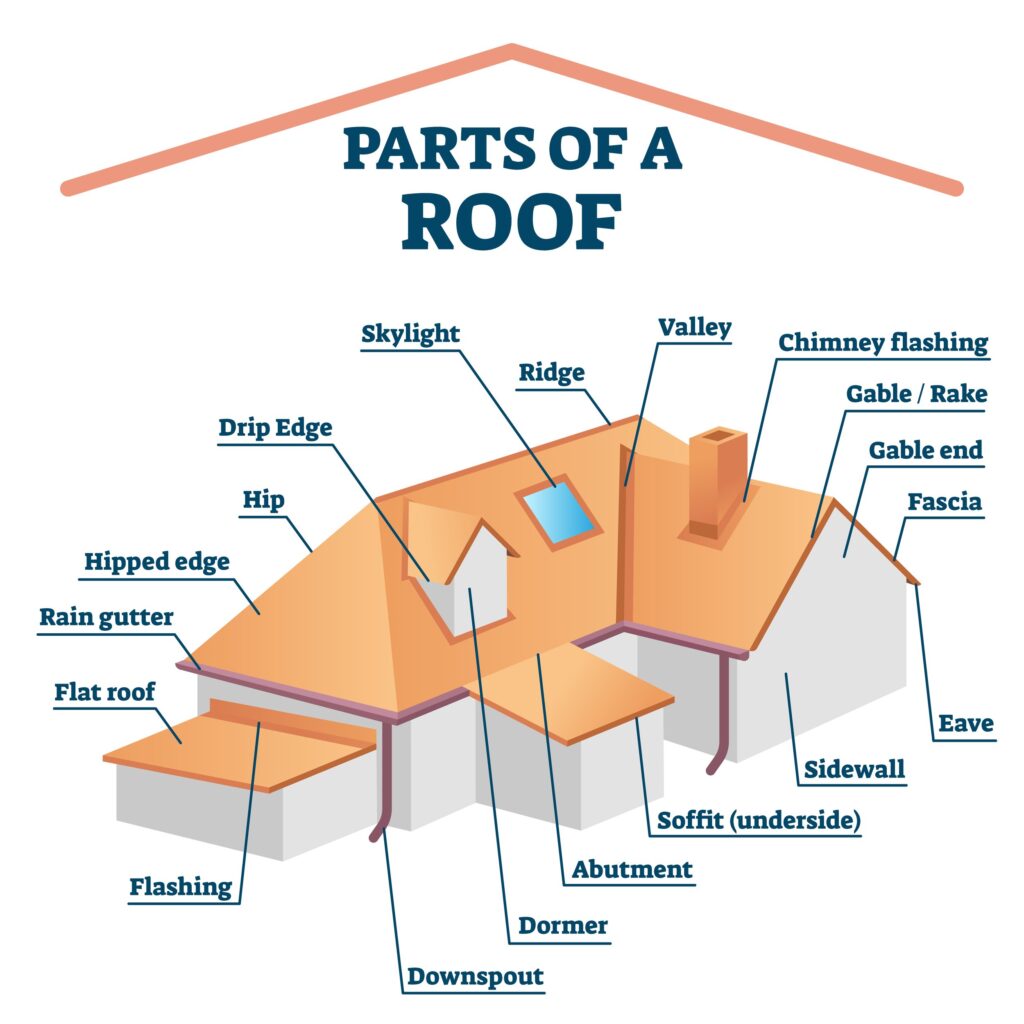So, you’ve noticed some issues with your home’s attic and you’re wondering if it’s properly vented. It’s an important question to ask, as proper ventilation is crucial for maintaining a healthy and well-functioning attic space. In this article, we’ll explore some telltale signs that can help you determine if your attic is properly vented or if it’s time to make some improvements. By understanding the indicators, you’ll be well-equipped to ensure your attic is receiving the ventilation it needs.
Signs of a Properly Vented Attic
Absence of excessive heat
When you have a properly vented attic, you won’t notice excessive heat inside the space. This means that during hot summer months, the temperature in your attic won’t become unbearably high. Without the proper ventilation, the heat can get trapped in your attic, potentially raising the temperature to dangerous levels. By ensuring that your attic is properly vented, you can create a more comfortable living environment in your home.
No signs of ice dams
Another sign of a properly vented attic is the absence of ice dams. Ice dams form when the heat from your home rises into the attic, causing snow on the roof to melt and then refreeze at the edges. Proper attic ventilation helps to prevent the buildup of heat in the attic, which in turn prevents the formation of ice dams. By keeping your attic properly vented, you can avoid the costly damage that ice dams can cause to your roof and home.
No moisture or condensation
A properly vented attic will also be free from moisture and condensation. When air becomes trapped in an attic without proper ventilation, it can lead to moisture buildup. This moisture can result in a variety of problems, including rotting wood and the growth of mold and mildew. By ensuring that your attic has enough ventilation, you can prevent these issues and maintain a dry and healthy attic space.
No musty or unpleasant smells
If your attic is properly vented, you won’t experience any musty or unpleasant smells in your home. Poor ventilation can result in a stale and unpleasant odor permeating your living space. This odor is often caused by the buildup of moisture and the growth of mold and mildew. By having proper ventilation in your attic, you can eliminate these unpleasant smells and create a more pleasant environment in your home.
Even temperature throughout the attic
Lastly, a properly vented attic will have an even temperature throughout the space. This means that there won’t be any noticeable variations in temperature from one area of the attic to another. Without proper ventilation, the heat can become trapped in specific areas, resulting in hotspots. By ensuring that your attic is properly vented, you can maintain a consistent temperature throughout the attic, preventing any potential issues that may arise from temperature fluctuations.
Importance of Proper Attic Ventilation
Preventing heat buildup
Proper attic ventilation is crucial for preventing heat buildup in your attic. In hot weather, the temperature in your attic can reach dangerously high levels if the heat is not properly ventilated. This excessive heat can not only lead to discomfort but also cause damage to the structure of your roof and your home. By allowing hot air to escape, proper attic ventilation helps to regulate the temperature, keeping your attic cooler and reducing the strain on your HVAC system.
Preventing moisture and condensation
Proper attic ventilation is essential for preventing moisture and condensation in your attic. When warm, moist air from inside your home rises into the attic and comes into contact with cooler surfaces, it can lead to condensation. This condensation can result in damage to your insulation, wood, and other materials in your attic, as well as promote the growth of mold and mildew. By providing proper ventilation, you can allow the moist air to escape, helping to keep your attic dry and preventing potential problems.
Preserving the integrity of the roof
Proper attic ventilation also plays a crucial role in preserving the integrity of your roof. Without adequate ventilation, the heat and moisture that build up in your attic can cause damage to the roof sheathing, shingles, and other roofing materials. Over time, this damage can lead to leaks, rot, and premature deterioration of your roof. By ensuring that your attic is properly vented, you can extend the lifespan of your roof and avoid costly repairs or replacement.
Enhancing energy efficiency
Having proper attic ventilation can also enhance the energy efficiency of your home. When your attic is not properly vented, the heat buildup in the summer can transfer to the rest of your home, making it harder for your air conditioning system to cool your living space. This can result in higher energy bills as your AC works harder to maintain a comfortable temperature. With proper attic ventilation, the heat is dissipated, allowing your AC to operate more efficiently and reducing your energy consumption.
Preventing ice dams
Proper attic ventilation is crucial for preventing the formation of ice dams. Ice dams occur when the heat from your home rises into the attic, causing the snow on your roof to melt and then refreeze at the edges. The refrozen water creates a dam, preventing proper drainage and potentially causing water to seep under your roof shingles. This can lead to water damage, leaks, and even structural issues. By ensuring that your attic is properly vented, you can prevent the buildup of heat and the formation of ice dams, protecting your roof and home from potential damage.
Protecting against mold and mildew
Proper attic ventilation is essential for protecting against the growth of mold and mildew. When moisture becomes trapped in your attic due to poor ventilation, it creates an environment that is conducive to the growth of mold and mildew. These fungi not only cause unpleasant odors but can also pose health risks to you and your family. By maintaining proper attic ventilation, you can prevent the buildup of moisture and inhibit the growth of mold and mildew, ensuring a safe and healthy living environment.


Common Problems with Attic Ventilation
Insufficient ventilation
One common problem with attic ventilation is insufficient airflow. If your attic does not have enough ventilation, it can lead to heat buildup, moisture problems, and mold growth. Insufficient ventilation is often caused by a lack of intake vents or exhaust vents, or inadequate ventilation openings. To address this issue, it is important to ensure that your attic has the proper balance of intake and exhaust vents and that they are sized correctly to provide adequate airflow.
Blocked or obstructed vents
Another common problem with attic ventilation is blocked or obstructed vents. Over time, debris, such as leaves, dirt, or bird nests, can accumulate in your vents, obstructing the airflow. This blockage can prevent the proper intake or exhaust of air and disrupt the ventilation process. Regular inspection and cleaning of your vents can help prevent this problem and ensure that your attic ventilation system functions effectively.
Improper vent placement
Improper vent placement is another common issue that can affect attic ventilation. If the vents are not located in the right positions, they may not be able to provide adequate airflow throughout the attic space. This can result in uneven temperature distribution and poor ventilation. It is crucial to consult with a professional or follow industry guidelines to ensure that your vents are placed correctly for optimal ventilation.
Inadequate insulation
Inadequate insulation can also contribute to attic ventilation problems. Insulation acts as a barrier between the conditioned living space and the unconditioned attic. If the insulation is not properly installed or is insufficient, it can impede the proper ventilation of your attic. It is important to ensure that your attic is properly insulated to promote efficient airflow and maintain the desired temperature within your home.
Assessing Attic Ventilation
Checking for signs of excessive heat
To assess the ventilation in your attic, you can start by checking for signs of excessive heat. Use a thermometer or temperature gun to measure the temperature in different areas of the attic. Ideally, the temperature should not exceed the outdoor temperature by more than a few degrees. If you notice significant temperature variations or if the temperature in your attic is excessively high, it may indicate a ventilation problem.
Observing for ice dam formation
Another way to assess attic ventilation is by observing for ice dam formation. Check the eaves of your roof for icicles or the presence of ice dams during winter months. If you notice these signs, it could be an indication that the heat from your attic is not properly vented, causing snow to melt and refreeze at the edges of your roof. Proper attic ventilation can help prevent the formation of ice dams.
Inspecting for moisture or condensation
Inspecting for moisture or condensation is another important step in assessing attic ventilation. Look for water stains or discoloration on the insulation, wood, or other materials in your attic. Excessive moisture and condensation can indicate a ventilation problem, as trapped air can lead to the buildup of moisture. Additionally, check for signs of mold or mildew, as these can thrive in moist environments and suggest inadequate ventilation.
Detecting musty or unpleasant smells
Pay attention to any musty or unpleasant smells in your home, as they can be indicative of poor attic ventilation. Use your sense of smell to identify any odors that may be originating from the attic. Musty smells, in particular, can suggest the presence of mold or mildew, which can be caused by insufficient ventilation. If you notice persistent or strong odors, it is important to investigate the attic further for potential ventilation issues.
Using a temperature gun or thermometer
Lastly, you can use a temperature gun or thermometer to measure the temperature of the attic space. Take readings in different areas of the attic to identify any significant temperature variations. Uneven temperature distribution may indicate a problem with ventilation, as proper airflow should result in a consistent temperature throughout the attic. Use the temperature readings to further assess the effectiveness of your attic ventilation system.


Checking for Signs of Excessive Heat
Measuring the temperature
To check for signs of excessive heat in your attic, you can use a thermometer or a temperature gun. Measure the temperature in various areas of the attic, taking note of any significant variations. Ideally, the temperature in the attic should be close to the outdoor temperature. If you find that the attic temperature is much higher than the outdoor temperature, it could suggest that the heat is not properly dissipating, indicating a ventilation problem.
Looking for signs of discoloration
Another sign of excessive heat in the attic is visible discoloration. Inspect the insulation, wood, and other materials in your attic for any signs of discoloration or charring. High temperatures can cause damage to these materials, resulting in discoloration or even scorch marks. If you notice any of these signs, it is important to investigate further and address potential ventilation issues.
Checking for hotspots
Check for hotspots in your attic, as they can indicate areas of excessive heat. Use your hand or a temperature gun to feel for any areas that feel noticeably hotter than the surrounding surfaces. Hotspots can suggest a lack of proper ventilation, as the heat becomes concentrated in specific areas. Identifying these hotspots can help you determine if there are any ventilation issues that need to be addressed.
Assessing the insulation
Examine the condition of the insulation in your attic to assess the effectiveness of your ventilation. Inadequate ventilation can cause the insulation to deteriorate and become less efficient in regulating temperature. Look for signs of compressed, damaged, or missing insulation, as these can indicate ventilation-related problems. Proper insulation is essential for maintaining an appropriately ventilated attic.
Observing for Ice Dam Formation
Checking for icicles
During winter months, check the eaves of your roof for the presence of icicles. Icicles hanging from the roof edge can suggest the formation of ice dams. Ice dams occur when heat from the attic causes snow on the roof to melt and then refreeze at the edges. If you notice a significant amount of icicles, especially near the eaves, it may indicate inadequate attic ventilation.
Inspecting the condition of the roof
Inspect the condition of your roof for any signs of ice dams or water damage. Look for areas where ice has accumulated on the roof surface or where water appears to be pooling. These signs can signal that the heat from your attic is not properly ventilated, leading to the formation of ice dams and potential water leaks. A well-ventilated attic helps to prevent the formation of ice dams and protects your roof from damage.
Looking for signs of water damage
Check the interior of your home for any signs of water damage, particularly in the upper levels or near the ceiling. Water stains, sagging drywall, or peeling paint can suggest that your attic ventilation is not functioning effectively. When heat is trapped in the attic due to poor ventilation, it can cause moisture to build up and lead to water damage. Identifying any signs of water damage can prompt you to address attic ventilation issues promptly.


Inspecting for Moisture or Condensation
Checking for water stains or discoloration
One way to inspect for moisture or condensation in your attic is to check for water stains or discoloration on the insulation, wood, or other materials. Look for any areas that appear darker or discolored compared to the surrounding surfaces. Water stains suggest the presence of moisture, which can be a result of poor attic ventilation. Identifying these stains can help you determine if your attic ventilation system requires improvement.
Assessing the attic insulation
Assess the condition of the attic insulation to determine if there are any moisture or condensation issues. Insufficient or damaged insulation can contribute to poor ventilation and result in moisture buildup. Look for signs of moisture on the insulation, such as dampness or a musty odor. Mold or mildew growth on or near the insulation also suggests excessive moisture. Properly functioning attic ventilation helps to prevent moisture-related problems within your attic.
Looking for signs of mold or mildew
Inspect the attic for any signs of mold or mildew growth. These fungi thrive in damp and poorly ventilated areas, making the attic an ideal environment for their development. Look for visible signs of mold or mildew, such as black or green patches on the surfaces. Additionally, pay attention to any musty smells, as they can indicate that mold or mildew is present. Proper attic ventilation helps to prevent mold and mildew growth by eliminating excess moisture.
Detecting Musty or Unpleasant Smells
Using your sense of smell
Use your sense of smell to detect any musty or unpleasant odors in your home. Walk around your living space and pay close attention to any odors that may be originating from the attic. If you notice a persistent musty smell, it could suggest the presence of mold or mildew, which is often caused by poor attic ventilation. Identifying these odors allows you to investigate further and address any ventilation issues that may be contributing to the problem.
Searching for sources of odor
Once you detect a musty or unpleasant smell, try to locate the source of the odor. Move through your home and follow your nose to pinpoint the area where the smell is the strongest. This can help you identify potential ventilation issues within your attic. Look for signs of moisture, mold growth, or the presence of animals or pests, as these can all be sources of unpleasant odors. By identifying the source, you can take the necessary steps to rectify the problem.
Inspecting for animal or pest infestations
Unpleasant smells in your attic may be an indication of an animal or pest infestation. Animals such as rodents or birds can find their way into your attic through gaps or openings and create nests or leave droppings behind. Pest infestations can contribute to poor attic ventilation by blocking vents or damaging insulation. Inspecting your attic for signs of animal or pest activity can help you determine if ventilation issues are related to these unwanted guests.


Using a Temperature Gun or Thermometer
Measuring the temperature of the attic space
To assess the effectiveness of your attic ventilation, you can use a temperature gun or thermometer to measure the temperature of the attic space. Take readings at different areas of the attic, including near the intake and exhaust vents, as well as in the middle of the space. This will give you a sense of the temperature distribution and whether there are any areas with significant variations. The temperature readings can provide insights into the airflow and overall ventilation efficiency.
Comparing temperature readings
Once you have measured the temperature in different areas of the attic, compare the readings to identify any significant temperature variations. Ideally, the temperature throughout the attic should be consistent. If you notice a large temperature difference between different areas, it could suggest inadequate ventilation. Proper airflow helps to maintain a balanced temperature within the attic, preventing heat buildup and ensuring effective ventilation.
Identifying any significant temperature variations
Significant temperature variations from one area of the attic to another can be an indication of ventilation problems. Hotspots, where the temperature is consistently higher than the surrounding areas, may suggest inadequate airflow and ventilation. Identifying these variations can help you determine if there are any obstructions or deficiencies in your attic ventilation system. Addressing these issues can promote better airflow and improve the ventilation in your attic.
Conclusion
Proper attic ventilation is crucial for maintaining a healthy and structurally sound home. By understanding the signs of a properly vented attic, the importance of proper attic ventilation, common problems with attic ventilation, and how to assess attic ventilation, you can ensure that your attic is adequately ventilated. Regularly checking for signs of excessive heat, ice dams, moisture or condensation, musty smells, and using a temperature gun or thermometer can help you identify any ventilation issues and take the necessary steps to maintain a well-ventilated attic. With proper attic ventilation, you can prevent heat buildup, moisture problems, roof damage, enhance energy efficiency, and protect against mold and mildew, ensuring a comfortable and healthy living environment for you and your family.








